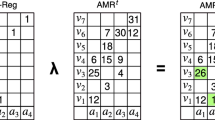Abstract
In this work a new Bidirectional Associative Memory model, surpassing every other past and current model, is presented. This new model is based on Alpha–Beta associative memories, from whom it inherits its name. The main and most important characteristic of Alpha–Beta bidirectional associative memories is that they exhibit perfect recall of all patterns in the fundamental set, without requiring the fulfillment of any condition. The capacity they show is 2min(n,m), being n and m the input and output patterns dimensions, respectively. Design and functioning of this model are mathematically founded, thus demonstrating that pattern recall is always perfect, with no regard to the trained pattern characteristics, such as linear independency, orthogonality, or Hamming distance. Two applications illustrating the optimal functioning of the model are shown: a translator and a fingerprint identifier.
Similar content being viewed by others
References
Hassoun MH (1993). Associative neural memories. Oxford University Press, New York
Kohonen T (1989). Self-organization and associative memory. Springer-Verlag, Berlin
McCulloch W and Pitts W (1943). A logical calculus of the ideas immanent in nervous activity. Bull Math Biophys 5: 115–133
Ritter GX, Sussner P (1996) An Introduction to morphological neural networks. In Proceedings of the 13th international conference on pattern recognition, (IV) Track D pp 709–717
Rosenblatt F (1958). The perceptron: a ;probabilistic model for information storage and organization in the brain. Psychol Rev 65(6): 386–408
Widrow B, Lehr MA (1990) 30 years of adaptive neural networks: perceptron, madaline and backpropagation. In: Proceedings of the IEEE 78(9) pp 1415–1441
Werbos PJ (1990) Backpropagation through time: what it does and how to do it. In: Proceedings of the IEEE 78(10) pp 1550-1560
Hopfield JJ (1982) Neural networks and physical systems with emergent collective computational abilities. In: Proc Nat Acad Sci 79:2554–2558
Minsky M and Papert S (1969). Perceptrons. MIT Press, Cambridge
Steinbuch K (1961). Die Lernmatrix. Kybernetik 1(1): 36–45
Willshaw D, Buneman O and Longuet-Higgins H (1969). Non-holographic associative memory. Nature 222: 960–962
Anderson JA (1972). A simple neural network generating an interactive memory. Math Biosci 14: 197–220
Kohonen T (1972). Correlation matrix memories. IEEE Trans Comput C-21(4): 353–359
Kosko B (1988). Bidirectional associative memories. IEEE Trans Syst Man, Cybernet 18(1): 49–60
Haines K and Hecht-Nielsen R (1988). A BAM with increased information storage capacity. IEEE Int Conf Neural Networks 1: 181–190
Leung CS and Cheung KF (1991). Householder encoding for discrete bidirectional associative memory. IEEE Int Joint Conf Neural Networks 1: 237–241
Shen D and Cruz JB (2005). Encoding strategy for maximum noise tolerance bidirectional associative memory. IEEE Trans Neural Networks 16(2): 293–300
Wang Y-F, Cruz JB and Mulligan JH (1991). Guaranteed recall of all training pairs for bidirectional associative memory. IEEE Trans Neural Networks 1(6): 559–567
Jiang X and Yau WY (2000). Fingerprint minutiae matching based on the local and global structures. In: Proc internat conf on pattern recognition 1038(-1041): 1038–1041
Wang Y-F, Cruz JB and Mulligan JH (1989). An enhanced bidirectional associative memory. IJCNN Int Joint Conf Neural Networks 1: 105–110
Tai H-M, Wu C-H and Jong T-L (1989). High-order bidirectional associative memory. Electron Lett 25(21): 1424–1425
Jeng Y-J, Yeh C-C and Chiveh TD (1990). Exponential bidirectional associative memories. Electron Lett 26(11): 717–718
Wang Y-F, Cruz JB and Mulligan JH (1990). Two coding strategies for bidirectional associative memory. IEEE Trans Neural Networks 1(1): 81–92
Wang Y-F, Cruz JB and Mulligan JH (1990). On multiple training for bidirectional associative memory. IEEE Trans Neural Networks 1(3): 275–276
Jeng Y-J, Yeh C-C and Chiueh T-D (1992). Generalised stable bidirectional associative memory. Electron Lett 28(15): 1396–1398
Yu H, Wang Z (1992) Bidirectional associative memories on the matching criterion of weighted Hamming distance. Proceedings of the 31st IEEE conference on decision and control vol 4, pp3481–3484
Lee D-L and Wang W-J (1993). Improvement of bidirectional associative memories by using correlation significance. Electron Lett 29(8): 688–690
Perfetti R (1993). Optimal gradient descent learning for bidirectional associative memories. Electron Lett 29(17): 1556–1557
Wang W and Lee D (1993). A modified bidirectional decoding strategy based on the BAM structure. IEEE Trans Neural Network 4(4): 710–717
Khorasani K, Cuffaro A and Grigoriu T (1994). A new learning algorithm for bidirectional associative memory neural networks. IEEE Int Conf Neural Networks 2: 1115–1120
Xu Z-B, Leung Y and He X-W (1994). Asymmetric bidirectional associative memories. IEEE Trans Syst Man Cybernet 24(10): 1558–1564
Oh H and Kothari S (1992). A Pseudo-relaxation learning algorithm for bidirectional associative memory. IJCNN 2: 208–213
Leung CS (1994). Optimum learning for bidirectional associative memory in the sense of capacity. IEEE Trans Syst, Man Cybernet 24(5): 791–796
Wang Z-O (1996). A bidirectional associative memory based on optimal linear associative memory. IEEE Trans Comput 45(10): 1171–1179
Sarkar D (1996). A three-stage architecture for bidirectional associative memory. IEEE Int Conf Neural Networks 1: 531/4–531/9
Haryono, Sadananda R, Phien HN (1997) Orthogonal schemes for bidirectional associative memories. IEEE Trans Syst, Man Cybernet B27(3):543-551
Sadananda R, Phien HN and Haryono (1997). Orthogonal schemes for bidirectional associative memories. IEEE Trans Syst, Man Cybernet B 27(3): 543–551
Ritter GX, Diazde Leon JL and Sussner P (1999). Morphological bidirectional associative memories. Neural Networks 12: 851–867
Wu Y and Pados DA (2000). A feedforward bidirectional associative memory. IEEE Trans Neural Networks 11(4): 859–866
Liang J and Cao J (2004). Exponential stability of continuous-time and discrete time bidirectional associative memory neural networks with delays. Chaos, Solitons Fractals 22: 773–785
Zheng G, Givigi SN, Zheng W (2005) A new strategy for designing bidirectional associative memories. Lecture Notes in Computer Science, vol 3496, Springer-Verlag, pp 398-403
Lee D-L and Chuang TC (2004). Design of general bidirectional associative memories with improved recall capability. Int J Neural Systems 14(5): 325–328
Chartier S and Boukadoum M (2006). A Bidirectional heteroassociative memory for binary and grey-level patterns. IEEE Trans Neural Networks 17(2): 385–396
Arik S (2005). Global asymptotic stability analysis of bidirectional associative memory neural networks with time delays. IEEE Trans Neural Networks 16(3): 580–585
Yáñez-Márquez C (2002) Associative memories based on order relations and binary operators (in Spanish) PhD Thesis. Center for Computing Research, México
Acevedo ME (2006) Alpha-Beta bidirectional associative memories (in Spanish) PhD Thesis. Center for Computing Research, México
http://bias.csr.unibo.it/fvc2000/download.asp
Author information
Authors and Affiliations
Corresponding author
Rights and permissions
About this article
Cite this article
Acevedo-Mosqueda, M.E., Yáñez-Márquez, C. & López-Yáñez, I. Alpha–Beta bidirectional associative memories: theory and applications. Neural Process Lett 26, 1–40 (2007). https://doi.org/10.1007/s11063-007-9040-2
Received:
Accepted:
Published:
Issue Date:
DOI: https://doi.org/10.1007/s11063-007-9040-2




